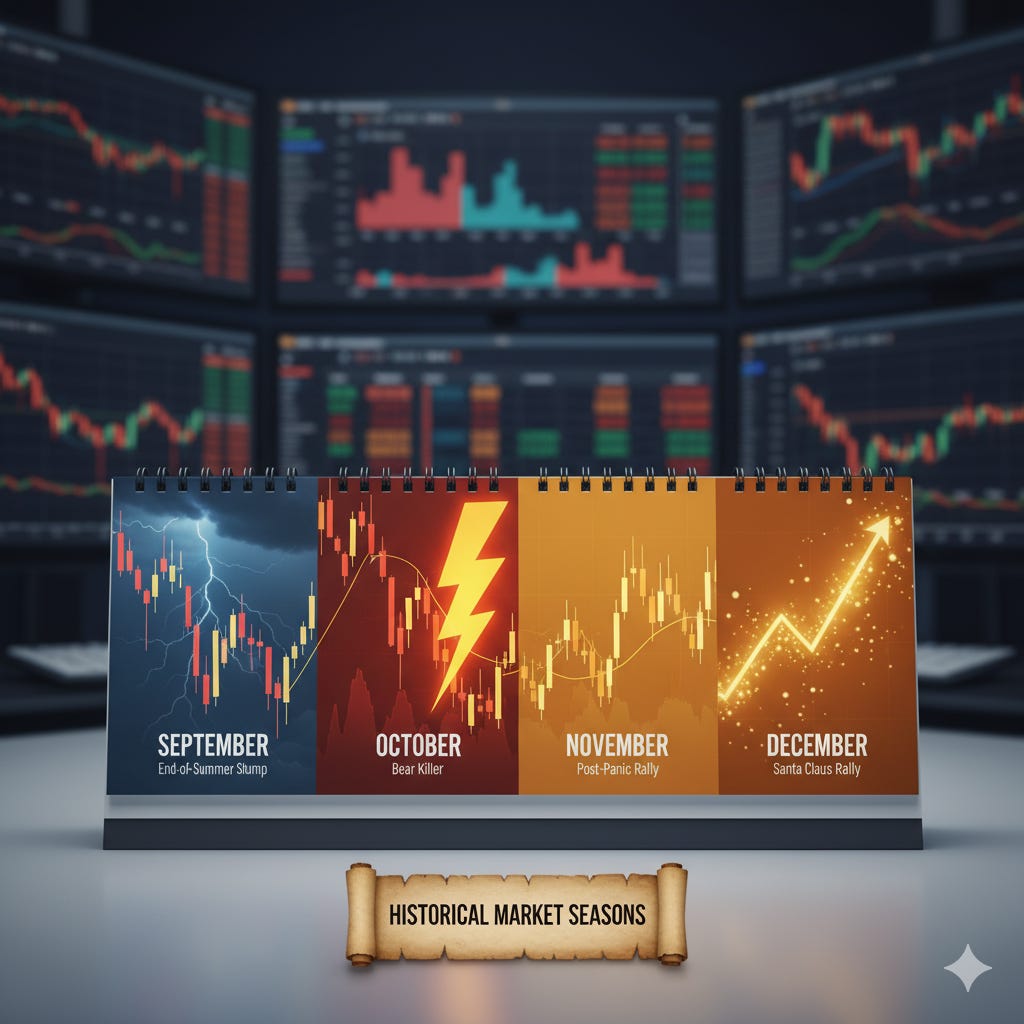Brace for Impact: Navigating the Market's Most Notorious Months
A data-driven guide to the historical weakness of September, the volatility of October, and the powerful year-end rally that often follows.
For months, the market has felt unstoppable. A powerful bull run has rewarded patience and conviction, making it easy to forget that markets also breathe. But with the end of August upon us and some recent wobbles in high-flying stocks like Nvidia, now is the time for professional traders to sharpen their focus and consult the historical map.
There are no crystal balls in trading. However, ignoring decades of seasonal data and market history would be like a sailor ignoring the weather forecast. As we head into what is historically the most treacherous part of the trading year, it’s our job to be prepared, not surprised. This isn't about predicting a crash; it's about understanding the probabilities so we can manage risk and seize the opportunities that volatility inevitably creates.
September: The End-of-Summer Slump
Statistically, September is the undisputed worst month of the year for the stock market. This isn't folklore; it's a persistent pattern backed by a mountain of data.
The Hard Numbers: Since 1950, the S&P 500 has averaged a decline of -0.7% in September. More importantly, it is the only month that has a "win rate" below 50%, finishing in positive territory only about 45% of the time.
There are several theories as to why this "September Effect" exists. Many traders return from summer vacation and begin to lock in profits or sell losers, leading to increased selling pressure. It also marks the end of the third quarter, a time when mutual funds often engage in "window dressing" and tax-loss harvesting. Whatever the reason, the historical headwind is undeniable. For traders, this means being extra cautious about chasing new highs and being mentally prepared for defensive, range-bound price action.
October: The "Bear Killer"
If September is a slow, grinding decline, October is known for its explosive volatility. It has a fearsome reputation as the month of market crashes—1929, 1987, and the 2008 financial crisis all saw their most dramatic moments in October.
But this reputation is only half the story. While October can be terrifying, it’s also known as the "Bear Killer."
A Month of Turning Points: Historically, more bear markets have ended in October than in any other month. The volatility that sparks panic often leads to a final, climactic washout of sellers, creating the conditions for a major market bottom.
A Deceptive Average: While its average return is slightly positive, that number hides the wild swings. October is a month of extremes, not calm averages.
For traders, October is a time for heightened alert. It’s not a month to be complacent. The potential for violent moves is high, but so is the potential for major trend reversals. This is when life-changing opportunities can appear for those who are prepared to act when fear is at its peak.
Q4: The "Santa Claus Rally" and the Powerful Finish
After navigating the treacherous waters of September and October, history shows that the market often rewards patient traders with a powerful year-end rally. The fourth quarter, and particularly November and December, is historically the strongest period for stocks.
A Season of Strength: November is historically one of the best months of the year, with the S&P 500 averaging a gain of over +1.5%.
The Santa Claus Rally: This refers to the market's tendency to rise during the last five trading days of December and the first two of January. But the positive sentiment often starts much earlier, with December as a whole being a very strong month historically.
This period is often fueled by holiday optimism, institutional performance chasing, and the use of year-end bonuses to invest in the market.
How I'm Preparing
Understanding this historical roadmap is the first step; aligning your strategy is the next.
Risk Management First: In September, I'll be especially focused on managing risk. This is not the time to be overly aggressive or chase extended moves. I will be patient and wait for high-probability setups at well-defined levels.
Embrace Volatility: I will be prepared for bigger swings in October. Wider stops and smaller position sizes can help navigate a volatile environment. I'll be watching for signs of capitulation that could signal a significant low is forming.
Look for the Turn: As we move into late October and November, I will be actively looking for signs that the seasonal weakness is ending and the traditional year-end strength is beginning to take hold.
Ultimately, we trade the market in front of us, not the market of the past. But by knowing where the historically dangerous currents and favorable winds are, we can navigate with skill, confidence, and a plan.
For a more detailed look at the entire year, check out my comprehensive post on market seasonality HERE.
Until next time—trade smart, stay prepared, and together we will conquer these markets!
Ryan Bailey,
VICI Trading Solutions


